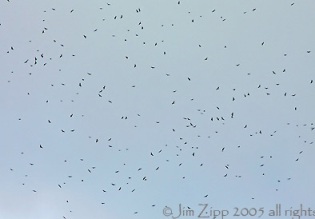
Today (Sunday, Sept. 26) we're enjoying one of the first noticeable cool fronts of the Fall season and it feels like hawk migration to me. One of the most amazing wildlife spectacles of North America is the annual Fall migration of raptors through Texas. If you ask the average Texan on the street, they'd probably understand that, yes, some hawks show up in the Fall and Winter, but unless you've peered for hours at the puffy white clouds rolling over the Texas Hill Country or plopped yourself down on a bluff overlooking the Nueces River just above Corpus Christi at this time of year, you may have missed this.
I saw no major movement today but this is a good time to prompt everyone to watch the weather for good migration movements on days like this. Any time from right now through mid-October is prime time. When conditions are right, if you see one hawk cruising overhead, a closer examination may actually reveal hundreds or thousands--and they may be just dots against the sky. I stare up at the sky in hopes of glimpsing these pre-eminent wind sailors. I get an empathetic rush of adrenaline when watching the graceful critters zip by. I'm earth-bound and envious: This is one of the most tantalizing displays of the mystery of avian migration. Last year we were lucky enough to glimpse a major movement on October 2 when 4,000-5,000 hawks sailed over the HQ in a matter of a few minutes.
Anticipation is everything: Hawkwatching is something of a feast or famine type of activity. Above all, raptors are smart at conserving energy and utilizing the prevailing wind currents to move from point A to point B. That means waiting until the strong cool fronts of the Fall to catch a ride. So on a hot September day when south winds are still bringing moist Gulf air over Central Texas, you can spend a long time looking at the sky and see nothing more than the local vultures moving to and fro. But when these cool fronts are coming through, hold onto your hat! Keep in mind also that the rumpled landscape of Balcones Canyonlands provides excellent topography for updrafts on which to "catch a wave".
Even on a good day with conducive winds such as today, other factors play a part in either concentrating the migrating hawks in certain areas, spreading them out over the landscape, shifting them from this ridge to that ridge, and so forth. You might watch the sky for a few hours and see hawks dribbling by in ones and twos, then all of a sudden a mass of Broad-winged Hawks or Swainson's Hawks will stream overhead, perhaps "kettling" up in a classic vortex when they find a good thermal or updraft, or streaming by high on set wings.

 On the left, your looking at a kettle of Broad-winged Hawks against a blue sky (ph. Jim Zipp).
On the left, your looking at a kettle of Broad-winged Hawks against a blue sky (ph. Jim Zipp).
On the right is Neal Smith's classic image of a huge kettle of Swainson's Hawks moving through Central America.
Hawks in the upper righ corner are actually streaming into the bottom of the kettle;
the rest of the birds are swirling to gain altitude in a thermal.
As many as 10 to 12 species of hawks might be seen on a good day here in the eastern Edwards Plateau. Sizeable numbers of the following species can be expected: Broad-winged Hawk, Swainson's Hawk, Sharp-shinned Hawk, Cooper's Hawk, and American Kestrel. Smaller numbers of just about everything else will spice up such a day, including Red-tailed and Red-shouldered Hawks, Ospreys, Northern Harriers, Merlins, and Peregrine Falcons*. Hawkwatching and hawk identification are the subject of a number of field guides and special publications. A handy chart for identifying the common species can be downloaded from the Hawk Migration Association of North America's webpage
here. I suggest checking out the following useful websites which have great information on these topics:
Texas Hawk Watches
Birds of North America Account of Swainson's Hawk Migration
Hawk Migration Association of North America
Hawkwatch International
Smith Point Hawk Watch and Gulf Coast Bird Observatory
For this Refuge,
Doeskin Ranch provides an excellent setting to scan the adjacent ridgelines and broad expanse of sky overhead. Some day, I'd hope we'll have the opportunity to develop and open a hawkwatching facility up on a high point of the Flying X tract, but that's a long way off. In the meantime, almost any high hill in Central Texas with an unobstructed view to the north and northwest will allow you a chance to intersect this amazing feathered energy flow.
Happy Hawkwatching!
* * * * *
Below The Line:
* Don't get fooled by all the rest of our feathered friends which might be moving on the same winds: Silent dark V's of cormorants are a regular sight on such days. If a "V" is honking, you might have geese (one of 3 or 4 possible species). If they have long legs and necks and are "tootling" [yes, I made up that word], then you're probably underneath a flight of Sandhill Cranes. If they are huge and white with black in the wings and are swirling gracefully in a big kettle, then your probably looking at American White Pelicans. And if they have long legs and necks and are black and white and are "tootling"...CALL ME IMMEDIATELY!! (This is more likely in the latter part of the Fall migration but we have had three confirmed sightings of Whooping Cranes over the Refuge in the past 10 years!)
